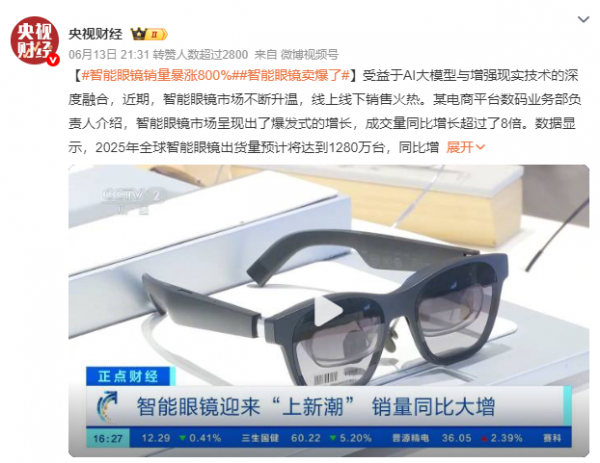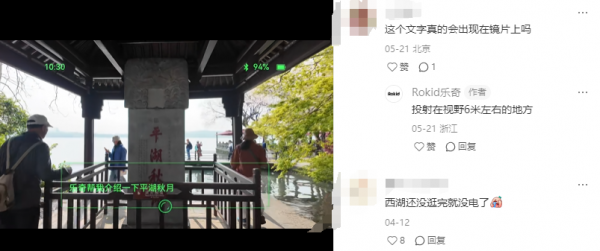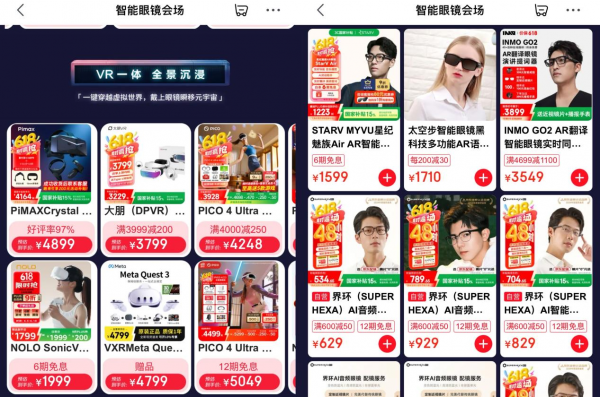Will AI Glasses Hit the Market as Prices Drop?
![]() 06/20 2025
06/20 2025
![]() 539
539

Image created by Doubao AI
Ease of use is a secondary concern for now
Written by Meng Huiyuan
Edited by Li Jinlin
Typeset by Annalee
On the eve of the 618 shopping festival, the AI glasses sector saw a flurry of new product launches, heralding the "Hundred Glasses Battle" that has engulfed the entire tech industry.
Major tech giants and startups unveiled their latest smart glasses, vying for a slice of this vast and promising market. From photo-taking and real-time translation to voice interaction, smart assistants, real-time transcription, and teleprompters, the expanding functionality aims to deliver an unprecedented smart experience to users.
Post-618, a deluge of consumer feedback poured in, shedding light on the true face of this heated market.
"Battery life is a significant issue. Even without active use, the battery lasts a maximum of 6-7 hours. With sound playback, it doesn't last 2 hours, and photo-taking reduces it further." "They're still bulky, with thick frames that hurt my ears after prolonged wear." "Sound leakage is a problem. Above 80% volume, people nearby can hear the audio. While the app has a privacy mode, it muffles the sound."... Clearly, for many early adopters, some AI glasses are "flashy but impractical".
Beneath the glossy exterior of AI glasses as high-tech products lie numerous pressing issues: Despite their innovative features, some AI glasses are criticized for short battery life, complex operations, and discomfort during wear. The intelligent experience of some products falls short of expectations, becoming a burden due to frequent charging and settings adjustments.
As consumer voices converge, the bubble in this nascent sector begins to surface.
Can half-baked products with insufficient battery life and limited functionality gain popularity?
Has the AI glasses market truly exploded?
Judging by the latest 618 data, this emerging consumer category has indeed shown a marked growth trend, with significant increases in both sales and transaction volumes. AI glasses from multiple brands have made it onto best-seller lists.
Recently, CCTV Finance reported that due to the deep integration of AI large models and augmented reality (AR) technology, the smart glasses market has experienced explosive growth. E-commerce platform data indicates that smart glasses transactions have surged over 8 times year-on-year, with both online and offline sales heating up. Analysts predict that the annual compound growth rate of smart glasses will exceed 60% from 2025 to 2029, with shipments in the Chinese market expected to reach 2.75 million units in 2025, a year-on-year surge of 107%, ranking first globally.

Source: CCTV Finance official Weibo
Huge discounts during the 618 shopping festival and heated national subsidies provided an excellent opportunity for consumers to experience smart glasses at a lower cost.
Previously, price was the main bottleneck hindering popularization. Mainstream products priced between 2000 and 5000 yuan posed a threshold for ordinary consumers. Currently, spurred by dual subsidies, many consumers are trying out AI glasses priced as low as a few hundred yuan, personally experiencing the allure of this future technology.
However, it cannot be overlooked that beneath this bustling scene lies a significant gap between consumers' expectations for ideal functionality and the actual product experience.
Some intended to use them for hands-free life recording from a first-person perspective but found battery life insufficient for daily shooting. Others wanted to experience AI features but encountered hardware limitations, with frequent freezing and impractical use. Some sought private music time but were troubled by sound leakage, forcing them to lower volume and sacrifice sound quality. Still, others used the teleprompter function to enhance professionalism only to find others could see the green subtitles on their glasses... These consumer experiences reveal critical issues in the AI glasses industry that cannot be ignored.
An industry insider noted, "Some current AI glasses on the market overly pursue conceptualization and gimmicks, ignoring user experience and actual needs, resulting in flashy but impractical product functions that are difficult to integrate into consumers' daily lives."
Returning to the essence of glasses as a product, they primarily serve people's daily wearing needs, with comfort and practicality being core elements. Even with AI as a selling point, it should not deviate from this original intent, too eager to showcase high-tech attributes while neglecting the basic functional attributes glasses, as a functional carrier, should inherently possess.
Among these, weight is a key factor in measuring wearing comfort. Zinc Scale found that this year's newly released AI glasses generally control their weight below 40g (due to individual myopia levels, lens weight varies, affecting overall weight), a significant improvement over early products weighing hundreds of grams.
However, battery life is the lifeblood of intelligent hardware products. Consumer feedback indicates that insufficient battery life is common among AI glasses products, becoming a major pain point restricting user experience.

Feedback from some users
Taking the new AI shooting glasses, LeTV V3, as an example, according to official customer service, "The built-in battery is 159mAh. Using the built-in battery, shooting lasts about 30 minutes (standalone), music playback lasts about 3 hours (standalone), and standby lasts about 18 hours (standalone)." Although it supports use while charging, the inconvenience it brings, such as cable constraints and usage scenario limitations, reduces product portability and practicality.
This is the primary contradiction of current AI glasses products - for a smart wearable device aiming to integrate into daily life, long battery life is fundamental, undoubtedly placing higher demands on hardware integration and lightweight design. However, improving battery life while maintaining portability is challenging. Current battery technology, while making some progress, still struggles to meet the demand for long-term use of high-energy-consuming devices like AI glasses.
Besides the dual challenges of battery life and weight, some AI glasses products also face numerous detailed tests in user experience. Issues include unnecessary embarrassment caused by sound leakage, the "green subtitle" leakage of the teleprompter function, unsmooth AI interaction experiences, and the lack of personalized services.
This has led many buyers to exclaim that what they bought may be a "half-baked product from the lab".
Secure market share first, then discuss quality upgrades
For manufacturers behind AI glasses products, while user experience is important, it becomes less so when compared to swiftly seizing the market.
When discussing hardware choices for implementing AI large models, Zhou Hongyi, the founder of 360, stated that glasses could be a direction for implementation. At that time, he also predicted that every internet company would make a pair of glasses in the future, forming a "Hundred Glasses Battle" competitive landscape.
Since the beginning of this year, the密集 release of a series of new products in the AI glasses sector has been validating Zhou Hongyi's prediction.

AR glasses function demonstration Source: Xiaohongshu
Just last month, multiple new products were launched: On May 5, Beijing Zhijing Weizhi Technology Co., Ltd., and StarOptics (the parent company of Baodao Eyewear) cooperated to release a dual-brand co-branded product, NSVE x BleeqUp AI sports shooting glasses; in mid-May, Lenovo unveiled the AI smart glasses "LeCool Fighter G1" focusing on photography functions, along with the AR smart glasses "V1"; on May 20, Google announced a partnership with the Chinese company XREAL to jointly release the new generation of AR glasses, Project Aura; on May 25, Liweike launched three AI glasses; on May 27, LeTV released three new AI glasses...
Major manufacturers are betting on AI glasses, all hoping to secure a share of this emerging market. The sector's bright future is evident from all indications.
According to independent monitoring data released by CINNO Research, domestic consumer-grade AI/AR glasses market sales reached 96,000 units in the first quarter of 2025, a year-on-year increase of 45%, indicating certain sales potential in the industry. IDC further predicts that shipments in the Chinese smart glasses market are expected to reach 2.907 million units in 2025, a year-on-year increase of 121.1%.
Even the secondary market maintains high attention and optimistic expectations for AI glasses. Recently, "China's first A-share smart imaging stock", Insta360 Innovation, was officially listed on the STAR Market, and its share price surged 330% from the issue price post-listing, with a market value exceeding 80 billion yuan. The short-term profit effect has further fueled market enthusiasm for speculating on concepts like AI glasses.
According to Xinda Securities' analysis, smart glasses products are gradually evolving from the stage of basic hardware overlay to smart assistance and intelligent assistants, expected to become intelligent collaborative and computing terminals in the future. "With overseas tech giants such as Meta, Apple, and Amazon, as well as domestic players like Xiaomi, Huawei, ByteDance, and the 'Four Little Dragons of AR' continuously iterating new products; models like GPT, Llama, Grok, Deepseek, Doubao, and Tongyi Qianwen constantly updating and upgrading; and waveguide technology continuously innovating in materials, processes, and technical paths, the takeoff of AI glasses may be faster than we expect."

AI glasses officially hit the table during this 618, with a dedicated consumer section
It's evident that the "experimental products" in consumers' mouths are actually a crucial tool for manufacturers to "grab land" in this new sector.
Although AI glasses still face numerous technical challenges and deficiencies in user experience, and the consumer market for this product is nascent, manufacturers obviously view it as a key part of the future smart device ecosystem.
By continuously launching new products, they are not only testing market response but also laying the groundwork for future market competition.
On one hand, manufacturers understand that AI glasses, as a new form of smart wearable devices, have potential far beyond a single product function. They are more like keys to the future metaverse world, capable of connecting the virtual and real, providing users with an unprecedented immersive experience. Therefore, everyone is exploring how to occupy this crucial traffic entrance.
On the other hand, manufacturers are actively building an ecosystem for AI glasses. They know that a single product is hard to stand out in fierce market competition. Only by building a comprehensive ecosystem can they attract more developers and users, aiming to maintain long-term competitiveness amidst increasingly fierce market competition.
In other words, ease of use comes later. The priority at this stage is to secure a position for oneself.
In the preheating stage of this "Hundred Glasses Battle", every step is crucial. Major manufacturers are well aware that even though the technology and applications of AI glasses are currently immature, those who can enter the market earlier, interact more actively with users, collect feedback, and quickly iterate their products will gain an advantage in the future.
As for the functional experience upgrades that consumers eagerly anticipate, their realization may take some time.







